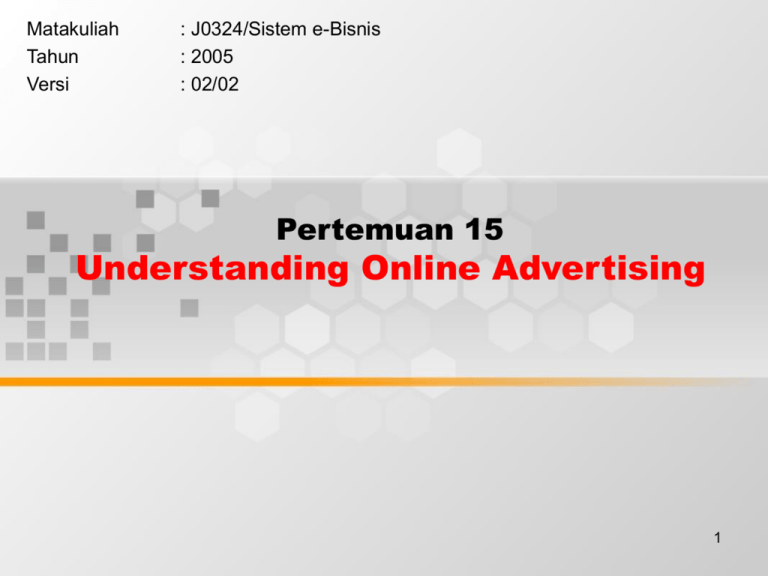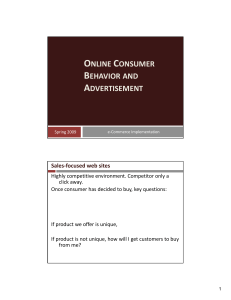Advertising - Binus Repository
advertisement

Matakuliah Tahun Versi : J0324/Sistem e-Bisnis : 2005 : 02/02 Pertemuan 15 Understanding Online Advertising 1 Learning Outcomes Pada akhir pertemuan ini, diharapkan mahasiswa akan mampu : • menunjukkan konsep penerapan promosi / periklanan online 2 Outline Materi • • • • Web Advertising Advertising Method Advertising Strategies and Promotions Economics of Advertising 3 Web Advertising • Overview – Advertising is an attempt to disseminate information in order to affect buyer-seller transactions – Interactive marketing: Online marketing, enabled by the Internet, in which advertisers can interact directly with customers and consumers can interact with advertisers/vendors 4 Web Advertising (cont.) • Internet advertising terminology – ad views: The number of times users call up a page that has a banner on it during a specific time period; known as impressions or page views – button – page 5 Web Advertising (cont.) – Click (click-through or ad click): A count made each time a visitor clicks on an advertising banner to access the advertiser‘s Web site – CPM (cost per thousand impressions): The fee an advertiser pays for each 1,000 times a page with a banner ad is shown – Hit: Request for data from a Web page or file 6 Web Advertising (cont.) – Visit: A series of requests during one navigation of a Web site; a pause of request for a certain length of time ends a visit – Unique isit: A count of the number of visitors to a site, regardless of how many pages are viewed per visit – Stickiness Characteristic that influences the average length of time a visitor stays in a site 7 Web Advertising (cont.) • Why Internet advertising? – Television viewers are migrating to the Internet – Statistics are not readily available on ads in a print publication or on TV – Cost – Richness of format – Personalization – Timeliness – Participation – Location-basis – Digital branding 8 Web Advertising (cont.) • Advertising networks advertising networks: Specialized firms that offer customized Web advertising, such as brokering ads and helping target ads to selected groups of consumers • One-to-one targeted advertising and marketing can be expensive, but it can also be very rewarding 9 Banner Ads • Banner: On a Web page, a graphic advertising display linked to the advertiser’s Web page • Keyword banners: Banner ads that appear when a predetermined word is queried from a search engine • Random banners: Banner ads that appear at random, not as the result of the viewer’s action 10 Banner Ads (cont.) • Benefits of banner ads – users are transferred to an advertiser’s site, and frequently directly to the shopping page of that site – the ability to customize some of them to the targeted individual surfer or market segment of surfers • “forced advertising”—customers must view ads while waiting for a page to load before they can get free information or entertainment that they want to see (a strategy called) – banners may include attention-grabbing multimedia 11 Banner Ads (cont.) • Limitations of banner ads – High cost of placing ads on high-volume sites – Limited amount of information can be placed on the banner • Click ratio: ratio between the number of clicks on a banner ad and the number of times it is seen by viewers; measures the success of a banner in attracting visitors to click on the ad 12 Banner Ads (cont.) • Banner swapping: An agreement between two companies to each display the other’s banner ad on its Web site • Banner exchanges: Markets in which companies can trade or exchange placement of banner ads on each other’s Web sites 13 Advertising Methods (cont.) • Pop-up ad: An ad that appears before, after, or during Internet surfing or when reading e-mail • Pop-under ad: An ad that appears underneath the current browser window, so when the user closes the active window, they see the ad 14 Advertising Methods (cont.) • Other intrusive advertising methods – – – – – – – – – Mouse-trapping Typo-piracy and cyber-squatting Unauthorized software downloads Visible seeding Invisible seeding Changing homepage or favorites Framing Spoof or magnet pages Mislabeling links 15 Advertising Methods (cont.) • Interstitial: An initial Web page or a portion of it that is used to capture the user’s attention for a short time while other content is loading • Users can remove these ads by simply closing them or by installing software to block them 16 Advertising Methods (cont.) • E-mail advertising – mailing lists via e-mail – advantages • low cost • the ability to reach a wide variety of targeted audiences – information on how to create a mailing list, consult groups.yahoo.com (the service is free), emailfactory.com, or topica.com 17 E-Mail Advertising (cont.) • E-mail advertising management includes: – preparing mailing lists – Deciding on content – measuring the results • Companies that help with e-mail advertising – worldata.com – emailresults.com 18 E-Mail Advertising (cont.) • E-mail advertising methods and successes – E-mail promotions—E-Greetings Network (egreetings.com) – Discussion lists—Internet Security Systems (ISS) – E-mail list management—L-Soft’s Listserv 19 Advertising Methods • Newspaper-like standardized ads – standardized ads are larger and more noticeable than banner ads – look like the ads in a newspaper or magazine (cont.) • Classified ads – – – – special sites online newspapers exchanges portals 20 Advertising Methods (cont.) • URLs – Universal Resource Locators – Search engines allow companies to submit URLs for free – Difficult to make the top of several lists – Improve ranking in the search engine by simply adding, removing, or changing a few sentences – Paid search engine inclusion 21 Advertising Methods (cont.) • Advertising in chat rooms – vendors frequently sponsor chat rooms – advertisers cycle through messages and target the chatters again and again – advertising can become more thematic – used as one-to-one connections between a company and its customers 22 Advertising Methods (cont.) • Advertorial: An advertisement “disguised” to look like an editorial or general information 23 • Source : Turban, Efraim, David King, Jae Lee and Dennis Viehland. Electronic Commerce. A Managerial Perspective (2004). Prentice Hall. PPT for Chapter :5 24




